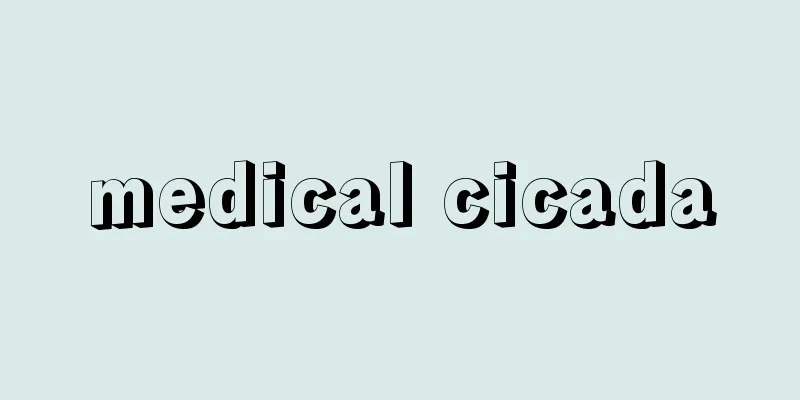Yellow rice - Ouhenmai

|
Various microorganisms can grow on rice, causing spoiled rice (disease rice). When Penicillium mold grows on rice, it produces a yellow or reddish-red substance that discolors the grains, and this spoiled rice is called yellow rice. In Japan, the existence of so-called native yellow rice, which, although very few in number, causes symptoms similar to those of beriberi when eaten, has long been known. During the food shortages following World War II, harmful Penicillium bacteria were isolated from some of the rice imported to Japan, and yellow rice became a hot topic of discussion, especially between 1954 and 1955 (Showa 29-30). There are three Penicillium species that are the main harmful microorganisms that cause yellowing rice. The first, Penicilum citreoviride , produces a neurotoxin that causes acute poisoning and, in severe cases, respiratory problems and death. The second, P. islandicum , produces a chlorine-containing cyclic peptide, cyclochlorotine (islanditoxin), along with anthraquinone pigments such as luteoskairin, rubroskairin, and rubrosin. Luteoskairin and islanditoxin are hepatotoxins, and luteoskairin is carcinogenic. The third, P. citrinum , produces a yellow pigment called citrinin, which is a hepatotoxin. [Fuwa Eiji] [Reference] |Source: Shogakukan Encyclopedia Nipponica About Encyclopedia Nipponica Information | Legend |
|
米に種々の微生物が繁殖し、変質米(病変米)を生ずることがある。ペニシリウム属のカビが米に生育すると、黄色あるいは赤紅色の物質を生産し、穀粒が着色するので、これらの変質米を黄変米とよんでいる。日本では昔からごくわずかであるが、食すると衝心脚気(かっけ)に類似した症状を示す、いわゆる在来黄変米の存在が知られていたが、とくに第二次世界大戦後の食糧難時代に、日本に輸入された米のいくつかから有害ペニシリウム菌が分離され、1954~1955年(昭和29~30)を中心に黄変米は大きな話題となった。 黄変米の原因となる有害微生物のおもなものとして、三つのペニシリウム属の菌があり、第一のシトレオビリドPenicilum citreovirideは、神経毒を生産し、このため急性中毒をおこし、ひどい場合には呼吸障害をおこし死に至る。第二のイスランジカムP. islandicumは、ルテオスカイリン、ルブロスカイリン、ルブロシンなどアントラキノン系色素群とともに含塩素環状ペプチド、シクロクロロチン(イスランジトキシン)を生産する。ルテオスカイリンとイスランジトキシンは肝臓毒であり、またルテオスカイリンは発癌(はつがん)性である。第三のシトリナムP. citrinumは、肝臓毒であるシトリニンという黄色色素を生産する。 [不破英次] [参照項目] |出典 小学館 日本大百科全書(ニッポニカ)日本大百科全書(ニッポニカ)について 情報 | 凡例 |
>>: European and American flora
Recommend
Deimos (English spelling)
A moon of Mars. Also called Deimos. It was discov...
Kitoku dialect
...Based on vocabulary and phonological character...
Shintan
Another name for China. It is of the same family a...
Nasal consonant - Bidakuon
In Japanese, it is the name of a syllable with a v...
Groote Eylandt (English spelling)
An island in the Gulf of Carpentaria, north of the...
Steel bar
A type of bar. It is a bar-shaped steel material m...
Luzula plumosa (English spelling) Luzulaplumosa
…[Tetsuichi Yahara]. … *Some of the terminology t...
Arima Yorishige
1828-1881 A feudal lord from the end of the Edo p...
Fujita Otozo
A Nagauta singer. There have been six generations ...
Maithilī (English spelling)
...In recent years, as the district capital, it h...
Confucian funeral
A funeral ceremony performed by Confucian scholars...
Greater flamingo - Oofuramingo
...The edge of the beak has a fine comb-like filt...
Oistrakh Trio - Oistrakh Trio
…He is also known for playing a wide range of rep...
Filters
Filters are used to transmit or block certain wav...
Kineya Rokusaburo (2nd generation)
[Born] 1710 [Died] 1791 (Kansei 3) Head of a shami...





![Logan [mountain] - Logan](/upload/images/67cd3a1456234.webp)



